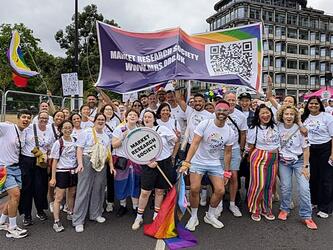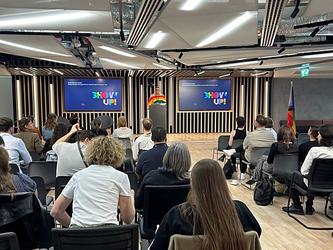Insights on authenticity from MRSpride: ‘Researchers have an obligation to tell those stories’

Inclusion has been a hot topic in recent years, but many attempts at representing diverse communities founder due to a lack of genuine engagement on the part of brands with the people they are trying to portray and represent.
The MRSpride Show Up! Insights Summit 2024 showcased several examples of engagement with the LGBTQ+ community, with calls for greater involvement of people with lived experience in market research, the development of advertising and product design.
The Diversity Standards Collective and E45 talked about a project to better understand how skin adapts to the gender transition journey, with the use of community research to give greater authenticity to the findings and inculcate greater engagement from the trans community. The project featured in medical journals and culminated in the release of online guides to help trans people understand any changes to their skin throughout the transition process.
Rich Miles, chief executive at The Diversity Standards Collective, said it was vital that brands include communities early on, and not just seek to portray people from marginalised groups in adverts without involving them in the design process. “If you have casting without culture, you are essentially going to have tokenism,” Miles said. “If you have culture without casting, you are going to have appropriation. You need to make sure you have culture and casting together. Culture is so nuanced and so subtle.”
Alex Gabbutt, head of community research at The Diversity Standards Collective, said it was important in research to concentrate on understanding community, context, culture and the individual. “Market research is really great at helping brands to navigate, but doesn’t always focus on community-level narratives – it sometimes focuses on very hard metrics,” Gabbutt said. “But specifically when thinking about creative production – media or marketing – at what point do the community you’re marketing to get brought in?
“How do you bring people in earlier in the production process or the creative journey? That will influence the elements of the representation of your specific community.”
Gabbutt added that “diverse casting isn’t the answer – context and culture are”, but said that representation needed to do more to show people’s joy and lived experiences. “We’re always thinking about ‘problematic’, we’re always thinking about ‘tokenism’, we’re always thinking about ‘appropriation’ – I’m bored of that,” he said. “I want to hear about ‘euphoria’, ‘joy’, ‘fun’ and community – I want to hear about those things. How can you as researchers create authentic space where the people you are speaking to can provide those?”
This could mean showing small and everyday experiences with a diverse cast, rather than solely focusing on major life events. “Researchers have an obligation to tell those stories if they can and when they should, and brands have an obligation to receive them well and to drive towards positive change creatively and with the community,” Gabbutt added.
In another session, Hannah Litchfield, client director at Bulbshare, discussed the company’s work with Durex on forming an online influencer community of people from the US, UK and China – some members of whom were from the LGBTQ+ community – that played a significant role in the brand’s work.
“This online influencer community has imprinted on everything Durex does, from communication to pack design to innovation and development,” Litchfield said. “We ensure diverse voices are heard all year around, and not just at key LGBTQI+ community moments. They are brought in early on to really explore the nuances in language, tone of voice and imagery between markets.”
Litchfield added: “The [LGBTQ+] community is evolving so fast, and companies and brands need to keep up with that. Language is a key part of that, as using inclusive language is really the first step towards implementing more inclusive behaviours overall.”
Victoria Landell Mills, senior insight executive at Bamm, also used an online portal to inform a project to design an underwear range inclusive for all genders, launched by Sloggi. Landell Mills said the online portal allowed the research team to “just take our participants at their word”, adding: “We didn’t ask ‘how long have you been non-binary?’, or ‘what was your identity before being non-binary?’. We just wanted to take them at their word.
“What was really lovely was nobody felt they had to prove their stripes to us – they could just be who they were and we were happy to have them.”
The research also highlighted some everyday experiences that could have very different connotations for non-binary people, with swimming particularly highlighted. “I hadn’t made the association with how much fear and dread was in this experience,” Landell Mills said. Equally, when designing underwear, previous examples for non-binary underwear either felt hyper-sexualised and overtly gendered, or very infantilisingly non-sexual, according to the panel members, findings which informed the final product.
Authenticity from brands is key, according to Alessia Cavallini, brand manager at Kantar, who made the point that progress is more important than perfection. “Now, more than ever, brands have a unique opportunity to champion inclusion and demonstrate genuine authenticity,” Cavallini said. “But simply showcasing diversity is not enough, and if you ask me it never has been. People buy authenticity rather than superficial representation. They want to see brands follow through on their words.”
Brands can get backlash for “tacking on diversity without doing the groundwork first”, Cavallini said, but they need to be brave, authentic and imperfect. Cavallini said that the Diva survey, run by Kantar to examine LGBTQ+ lives, had included allies of the community in the survey for the first time this year. “Being an ally is about creating a safe space for people to be themselves,” Cavallini added. “Allyship is a journey of continuous learning and unlearning. It is prioritising progress over perfection. It is active engagement rather than passive observation.
“I wish that progress over perfection can be and will be everyone’s mantra from now on – to keep moving, to avoid being stuck and fear of making mistakes. Inclusion, more often than not, also means confronting personal biases and learning and relearning.”

We hope you enjoyed this article.
Research Live is published by MRS.
The Market Research Society (MRS) exists to promote and protect the research sector, showcasing how research delivers impact for businesses and government.
Members of MRS enjoy many benefits including tailoured policy guidance, discounts on training and conferences, and access to member-only content.
For example, there's an archive of winning case studies from over a decade of MRS Awards.
Find out more about the benefits of joining MRS here.














0 Comments